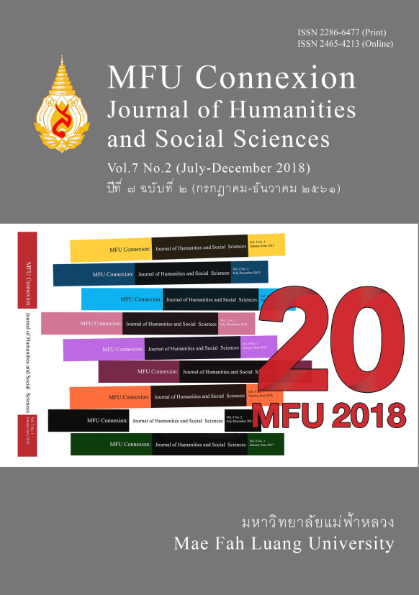Klong Kon Yao: The Transnational Music from Shan State to Northern Thailand (in Thai)
Main Article Content
Abstract
This article was intended to discuss about the current transnational movement of Klong Kon Yao in the northern Thailand. The Study found that the center of music transnationalism came from Shan State in the North of Myanmar. The increase of migration of Tai caused by the political crisis in Myanmar and the growth of Thailand's economy over the past two decades. The migration of Tai brought out the wide spread of Klong Kon Yao and cultural assimilation in the North of Thailand. The influence of Klong Kon Yao brought the changes to Pujae Drum, the lanna music instrument in Northern Thailand. The Influence of Klong Kon Yao caused Chiang Mai local musician to call for the preservation of Puje Drum in Chiang Mai province. This phenomenon reflects the incomplete process of cultural assimilation.
Article Details
Copyright
Connexion: Journal of Humanities and Social Sciences has an exclusive right to publish the accepted articles in any form. However, the author retains the following rights:
1. The right to the ownership of the article;
2. The right to use all or part of the article in his/her other works;
3. The right to re-produce the article for personal use or for use in the author’s organisation, in which case the author must obtain permission from Connexion: Journal of Humanities and Social Sciences;
4. The right to make copies of all or part of the work for educational use or for the author’s use in classroom teaching; and
5. The right to include the work (both the preprinted and printed versions) in an institutional repository.
References
Adorno, T. (1941) The musical material, Available: http://www.icce.rug.nl/~soundscapes/DATABASES/SWA/On_popular_music_1.shtml [3 June 2014]
Appadurai, A. (1949) Modernity at large: Cultural dimensions of globalization, Minneapolis: University of Minnesota Press.
Donkor, A. D. (2016) Assimilation and social success, cultural Identity of second generation Nigerian migration in Oslo, Norway, Master’s thesis, MF Norwegian School of Theology, Norwegian.
Duangwises, D. (2017) Transnationalism (การข้ามพรมแดนรัฐชาติ), Princess Maha Chakri Sirindhorn Anthropology Centre, Available: https://www.sac.or.th/databases/anthropology-concepts/glossary/153 [25 December 2018] (in Thai)
Frith, S. (1996) ‘Music and identity’, in S. Hall & P. Du Gay (Eds.), Questions of cultural identity (pp. 108-127), Thousand Oaks, CA: Sage Publications.
Gunteewong, N. (2014) The surveying of cultural space of Lanna drum (การสำรวจพื้นที่วัฒนธรรมการตีกลองล้านนา), Chiang Mai: Project of Lanna Studies, Chiang Mai University press. (in Thai)
Hamlink, C. (1983) Cultural antinomy in global communication, New York: Longmans.
Hudson, R. (2006) Region and place: Music, identity, and place, Progress in Human Geography, vol. 30, no. 5, pp. 626-634.
Inkhong, O. (2016) ‘Composing sound identity in Shan Long Drum’, in 12th International Burma Studies Conference: Traditions and Challenges, on 6-9 October, 2016, Available: https://burmaconference2016.weebly.com/uploads/5/2/1/8/52185987/all_abstracts_final.pdf [20 December 2018]
Kamkom, P., et al. (2016) The cultural music of Tai, percussion and bowing instrument in Shan State Myanmar (วัฒนธรรมการบรรเลงดนตรีไทใหญ่ประเภทเครื่องตีและเครื่องเป่าในรัฐฉานสาธารณรัฐแห่งสหภาพเมียนมา), Journal of Fine Arts, vol. 7, no. 1, pp. 45-56, Available: https://doi.nrct.go.th/ListDoi/listDetail?Resolve_DOI=10.14457/CU.res.2015.9 [25 December 2018]
Kong, L. (1997) Popular music in a transnational world: The construction of local identities in Singapore, Asia Pacific Viewpoint, vol. 38, no. 1, pp. 19-36.
Lan na Tai Ethnics Leaning Center. (n. d.) Tai Yai, Available: https://www.sri.cmu.ac.th/~lelc/index.php/2015-11-18-16-02-19 [20 December 2018]
Maclachlan, H. (2016) The transnational flow of music from Burma to the United States, Journal of Burma Studies, vol. 20, no. 1, pp. 31-62.
Mamattah, S. (2006) Identity and marginality, Migration and Transnationalism, vol. 2, no. 6, Available: https://www.gla.ac.uk/media/media_41186_en.pdf [20 December 2018]
Masiri, M. (2016) Changes in Lanna musical identity (การเปลี่ยนแปลงอัตลักษณ์ของดนตรีพื้นเมือง, Doctoral dissertation, Mae Fah Luang University, Chiang Rai (in Thai)
Miller, E. T. & Williams, S. (eds.). (1998) Southeast Asia, New York: Garland.
Nakhonket, K. (n.d.) Concept and theory of social network (แนวคิดและทฤษฎีเครือข่ายทางสังคม), Nonthaburi: Ministry of Public Health of Thailand Press. (in Thai)
Phanchon, S. (2014) Seua Khan Fah: The Tale of Hero Prince in Tai literature (เจ้าเสือข่านฟ้า: เรื่องเล่าวีรบุรุษในวรรณกรรมไทใหญ่), Master’s thesis, Chiang Mai University, Chiang Mai. (in Thai)
Pidokrajt, N. (1995) ‘The sound resonance of Khlong Luang (เสียงลูกปลายของกลองหลวง)’, in Lanna music: Proceeding of the 26th of Thai Traditional Music Festival for Higher Education, pp. 137-144, Bangkok: Amarin Printing & Publishing. (in Thai)
Pornprasit, K. (2012) Klong Konyao: Performance methods and ensemble practices (กลองก้นยาว: ระเบียบวิธีการบรรเลงและการประสมวง), Journal of Fine Art, vol. 22, no. 2, pp. 28-44. (in Thai)
Solomon, T. (2015) African musics in context: Institutions, culture, identity, Kampala: Fountain Publishers.
Starr, L & Waterman, C. (2007) American popular music, England: Oxford University Press.
Subinmit, S. (2004) Klong Kon Yoa: Tai music instrument in Amphoe Muang Mae Hong Son Province (กลองก้นยาว: เครื่องดนตรีชาวไทใหญ่ ในอำเภอเมือง จังหวัดแม่ฮ่องสอน), Master’s thesis, Mahidol University, Nakhon Pathom. (in Thai)
Tramote, M. & kooltun, W. (2523) Listen and understand to Thai song (ฟังและเข้าใจเพลงไทย), Bangkok: Thaikasem Press. (in Thai)


